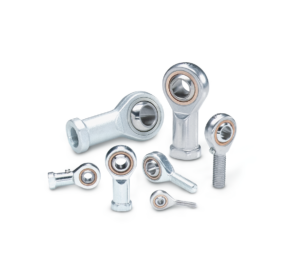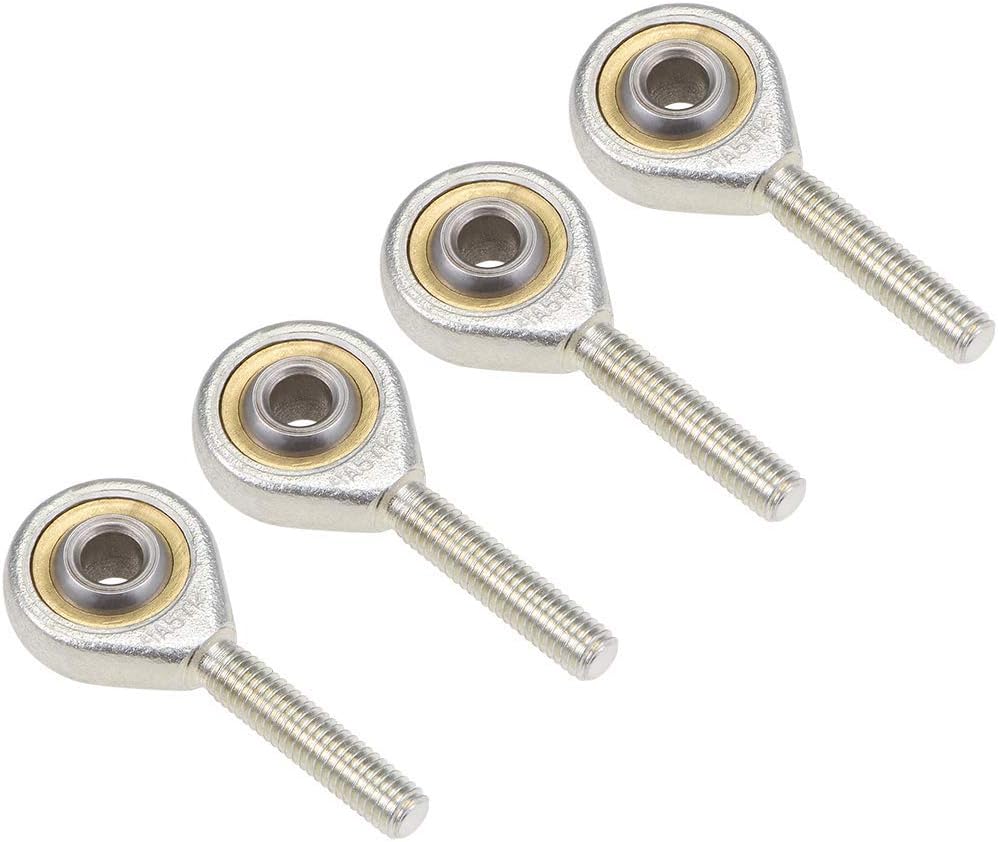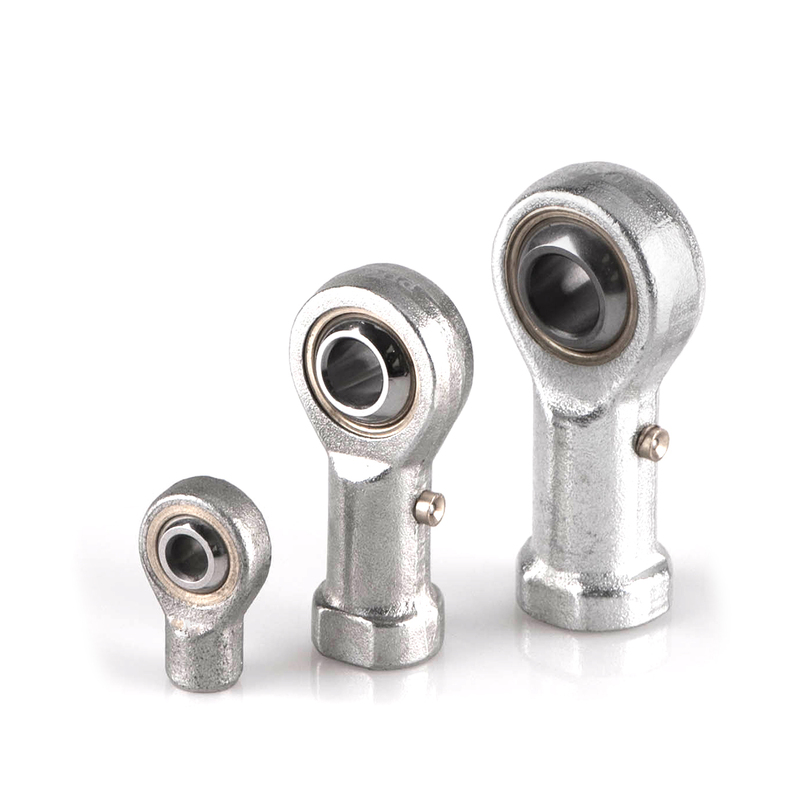Product Description
Product Description
Features
• Sliding contact surface: steel/PTFE
• Lubricating: Maintenance-free
• Housing: 304 stainless steel
• Inner ring: 420 stainless steel, heat treated HRC54-60
• Outer Ring: 304 stainless steel
• Liner: PTFE
Rod end bearing consist of an eye-shaped head with integral shank forming a housing and astandard spherical plain bearing, or a spherical plain bearing inner ring, or a spherical plainbearing inner ring and a sliding layer between the bore of the head and the inner ring. As a rule.rod ends are available with left or right-hand female or male threads.
Bearings have better load carrying capacity
High-quality materials smooth surface, fee comfortable, corrosionresistance bearings
High quality and High precision
Reasonable price
Low friction, low vibration and low noise, long life
| Certificate | ISO, SGS |
| Material | Gcr15, Stainless steel, etc |
| Size | 5-55mm |
| Thread | Inside and outside, Left and right |
| Precision Rating | P0 P6 P5 P4 P2 |
| Use | CNC machinery, Auto, Tractor |
| OEM Service | Available |
| Packing | In carton or box or gunny bag then on steel pallet |
| Production Capacity | 500T/month |
| Sample Time | Within 3 days after confirmation |
| Delivery Time | 30-35days after the formal order or according to your order quantity |
| Port | HangZhou, ZheJiang , ZheJiang |
| Shipment | By sea/air, or express(FedEx, UPS, DHL, etc.) |
| Payment | T/T, L/C |
| Remark | Special specifications can be made by customer’s requirements |
| Main Products |
Shackles, Turnbuckles, Eye bolts, Chains, Wire rope, Wire rope clip, Wire rope ferrule, Thimble, Pulley, Hook, Quick link, Swivel, Cargo control products, Anchor&anchor chains, etc. |
Product application
Our Advantages
Certifications
Packaging & Shipping
FAQ
Q: Where to find Other bearings ?
Discover the Homepage—–> Products
Q: HOW TO CHOOSE A BEARING?
To properly choose a ball bearing, the important thing is to take into account several parameters:
1. Its application
Bearings are everywhere and therefore their applications are varied:
- – Agriculture (agricultural machinery, tools, …)
- – Domestic (turntable, fishing rod, rollers, …)
- – Industry (assembly lines, industrial machinery, …)
- – Machines (tools, robots, …)
- – Vehicles (cars, motorcycles, bicycles, trailers, …)
- – Office (fans, ….)
The application for which the bearing will be used will therefore be decisive in the choice of the part.
2. The speed of rotation
The ball bearing supports high speeds and reduced loads, while the tapered roller bearing supports higher loads but lower speeds.
The speed limits of a bearing are determined by the operating temperature.
The speed limit can be defined as the highest rotational speed a ride can achieve depending on use, without compromising performance and duration.
The speed limit of bearings depends on several factors, such as: bearing type, load size, tolerance class, cage configuration, work set, lubricant, lubrication and cooling conditions, etc.
3. The supported load
– Basic Dynamic Load
This is the maximum permissible load of the bearing capable of providing a nominal service life equal to 1 million revolutions.
It is necessary to calculate the service time necessary to show signs of fatigue on the materials, and on this basis to determine the theoretical duration.
– Static charge
This is the load that applies to the stationary bearing. It corresponds to a contact stress calculated between the rolling body in the most loaded contact and the raceway.
The loads are of simple type and radial, for the radial bearings, of simple type and axial, for
the abutments.
4. Life of bearings
Bearing life is defined as the number of revolutions or hours of operation, which the bearing is CZPT to withstand before signs of fatigue appear on 1 of the rings, on the raceway or on the rolling elements.
5. Nominal fatigue life
The rated fatigue life of an identical bearing or batch of bearings operating under the same service conditions shall be equivalent to at least a 90 degree of reliability.
The average life of a bearing lot is much greater than its nominal duration.
The nominal fatigue life is expressed as L10 (Million revolutions) or L10h (service hour).
6. Bearing tolerance
Bearing tolerances have been standardized both nationally and internationally in accordance with ISO standards.
Bearings are generally manufactured in the P0 tolerance class.
Other parameters can be studied to choose the bearing best adapted to your needs:
- – The conditions of use and the constraints
- – The requirements of duration of the machine
- – The mimics of congestion of the bearing
- – Negative factors (vibration, shock, heat, dirt, acceptable sound level, etc.)
The choice of bearing is therefore mainly dictated by the dimension and load characteristics to which the bearing is subjected.
In order to supply even more stable quality to our vast customers, we established a factory in HangZhou city, ZHangZhoug province, China, near HangZhou and ZheJiang port, which has recognized by special ISO. The various bearings we produce there have been inspected and confirmed by SGS to be RoHS compliant.
Besides we has a genuine concern about our customers’ needs and desires, we believe that by establishing a mutually beneficial relationship with our customers we can both continue to grow and prosper, we wish and hope to always grant you satisfaction.
Q: HOW TO MEASURE A BEARING?
You have to change your ball bearing but do not know the model?
There is no written reference to it and you are lost?
You do not have a sliding foot?
The measurement of the bearing will allow you to find this bearing or an equivalent.
GNYARBearing helps you to take accurate measurement.
1st step: the inside diameter of the bearing (called the bore)
- A / Put your bearing on the grid as shown in the diagram, taking care to justify the inside edge.
- B / Mark the inner contour.
- C / For ease of reading, do not hesitate to draw lines to the axes and then take the measure.
/* January 22, 2571 19:08:37 */!function(){function s(e,r){var a,o={};try{e&&e.split(“,”).forEach(function(e,t){e&&(a=e.match(/(.*?):(.*)$/))&&1
| Rolling Element: | Single Row |
|---|---|
| Structure: | Rod End |
| Material: | Bearing Steel and Stainless Steel |
| Load Direction: | Thrust Spherical Plain Bearing |
| Add Lubricant: | Non Self-lubricating |
| Outer Structure: | Normal |
| Samples: |
US$ 1/Piece
1 Piece(Min.Order) | |
|---|
| Customization: |
Available
| Customized Request |
|---|

Selecting Size and Thread Type for Rod End Bearings
When choosing the appropriate size and thread type for a rod end bearing, several considerations are important:
1. Load Requirements: Determine the expected loads the rod end bearing will need to support. Choose a size and material that can handle these loads without deformation or premature wear.
2. Thread Direction: Consider whether you need left-hand or right-hand threads. This depends on the specific application and the direction in which the rod end bearing will be subject to forces or adjustments.
3. Thread Size and Pitch: Select the thread size and pitch that match the mating components or the mounting point. Ensure compatibility to avoid threading issues during installation.
4. Environmental Conditions: Consider the operating environment. If the rod end bearing will be exposed to moisture, chemicals, or extreme temperatures, choose a material and thread type that can withstand these conditions without corrosion or degradation.
5. Lubrication: Evaluate the lubrication method. Some rod end bearings have built-in lubrication features, while others require external lubrication. Ensure that the selected bearing and thread type align with your lubrication approach.
6. Misalignment Requirements: If the application involves misalignment, select a rod end bearing with appropriate articulation capabilities, which may require specific size and thread choices to allow for the necessary movement.
7. Compatibility: Ensure that the rod end bearing’s size and thread type are compatible with the connecting components, such as linkages, control arms, or push/pull rods.
8. Adjustability: In applications where adjustability is required, consider rod end bearings with male and female threads to allow for fine-tuning and alignment.
9. Regulations and Standards: Check if there are industry or safety regulations that dictate specific size or thread requirements for your application.
10. Maintenance: Consider ease of maintenance. Some rod end bearings have features that facilitate inspection and lubrication, which can be essential for extending their lifespan.
11. Cost and Availability: Finally, factor in the cost and availability of the chosen rod end bearing size and thread type. Ensure it fits within your budget and can be readily sourced when needed.
By carefully evaluating these considerations, you can select the most suitable rod end bearing size and thread type for your specific application, ensuring optimal performance and longevity.

Contribution of Rod End Bearings to Smooth Movement in Automotive Control Systems
Rod end bearings play a crucial role in ensuring the smooth movement of control systems in various automotive applications. Here’s how they contribute:
1. Steering Systems:
Rod end bearings are used in steering linkages and tie rod ends. They provide the necessary articulation and pivoting to allow the front wheels to turn smoothly, enabling precise steering control. The low friction and high load-bearing capacity of rod end bearings contribute to responsive and accurate steering in both manual and power steering systems.
2. Suspension Systems:
In suspension systems, rod end bearings are used in components like control arms and stabilizer links. They allow for controlled movement of the suspension, ensuring that the vehicle’s wheels maintain optimal contact with the road surface. This contributes to a smoother and more comfortable ride, improved handling, and better traction, especially when driving over uneven or bumpy terrain.
3. Throttle and Accelerator Linkages:
Rod end bearings are employed in throttle and accelerator linkages, where they assist in transmitting pedal inputs to the engine’s throttle body. The smooth articulation provided by rod end bearings ensures that drivers can easily modulate engine power, contributing to smooth acceleration and deceleration.
4. Gear Shift Linkages:
In manual transmissions, rod end bearings are used in gear shift linkages. They enable precise and smooth gear changes by allowing for the controlled movement of the shift lever. This ensures that gears engage smoothly, reducing drivetrain shock and vibration.
5. Convertible Roof Mechanisms:
In convertible cars, rod end bearings are used in the mechanisms that operate the folding and unfolding of the convertible roof. The smooth articulation of rod end bearings contributes to the seamless transition between open and closed roof positions, enhancing the overall driving experience.
Overall, rod end bearings are integral components in automotive control systems, ensuring the smooth and precise operation of various critical functions, including steering, suspension, throttle control, gear shifting, and convertible roof movement.

Applications and Industries Using Rod End Bearings
Rod end bearings find application across various industries and serve multiple purposes due to their versatility and design. Common applications and sectors where rod end bearings are used include:
1. Automotive: Rod end bearings are utilized in vehicle suspension systems, steering linkages, and throttle linkages, contributing to precise control and smooth movement.
2. Aerospace: They play a crucial role in aircraft control systems, ensuring reliable and precise movement in critical flight control components.
3. Construction and Heavy Machinery: These bearings are used in heavy equipment like cranes, excavators, and loaders for precise positioning and movement in various parts of the machinery.
4. Manufacturing: In manufacturing machinery, rod end bearings are employed for automation and motion control applications, ensuring accurate and smooth movement in industrial processes.
5. Agricultural Equipment: Farm machinery, such as tractors and combines, use rod end bearings in steering systems, hydraulics, and other mechanical components.
6. Robotics: Rod end bearings are critical in robotic arms and automation systems, facilitating precise movement and control in manufacturing, medical, and other industries.
7. Marine and Offshore: They are used in marine applications, contributing to reliable control and movement in boat steering systems and offshore equipment.
8. Medical Equipment: In medical devices and equipment, rod end bearings ensure precise and smooth movement, making them essential in applications like surgical robots and diagnostic instruments.
9. Racing and Motorsports: Rod end bearings are used in high-performance vehicles for suspension and steering systems, where precise control is paramount.
10. Material Handling: Conveyor systems and material handling equipment benefit from rod end bearings, ensuring efficient movement and transport of goods.
11. Renewable Energy: They play a role in solar tracking systems and wind turbine applications, helping to adjust panel angles and rotor blades for optimal energy capture.
12. Rail and Transportation: In rail systems and transportation equipment, rod end bearings are employed in various components, including doors, brakes, and suspension systems.
13. Sports and Fitness Equipment: In gym equipment and sports machinery, they provide smooth and reliable motion in treadmills, exercise bikes, and more.
Rod end bearings are valued for their ability to provide reliable and precise movement in a wide range of applications, contributing to the efficiency and safety of various industries.


editor by CX 2024-04-12